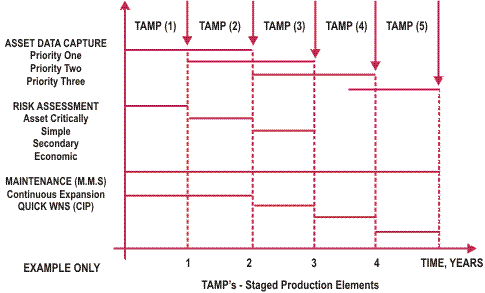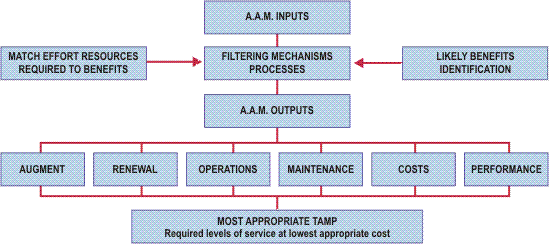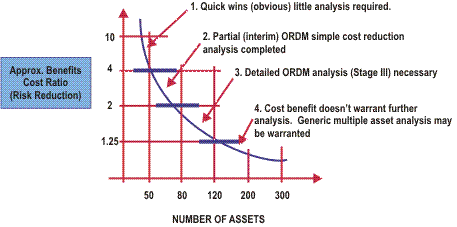Production Strategy
This topic covers:
The production of TAMP is a costly activity, and consideration needs to be given to the efficiency with which they are developed.
It is also important to consider the effectiveness of various activities, and the associated benefits, such as the:
- Degree to which the TAMP are accepted by the organization as a whole
- Commitment that is achieved to the outputs of the plans
- Degree to which the system management planning process is accepted by the organization at all levels
- Use of this information in improving day to day activities
- Performance monitoring and quality assurance aspects.
Several approaches have been used by service delivery authorities in the production of total asset management plans, including:
- Produced from Asset Management experts:
- In-house expert groups
- Expert Consultants
- A blend of the above
- A business unit team approach that involves staff at all levels
- A team approach between asset management expert groups and staff at all levels within the organization or business unit.
The options adopted by various organizations are affected by their immediate business needs and objectives, such as:
- The current availability of data
- The current knowledge of staff in respect to TAMP production
- The availability of staff resources
- The timeframe in which the TAMP is required.
It is important to decide whether all staff should become totally familiar with the approach, and whether resources and timing allow for total staff participation.
Whether the resources allocated to perform the production task is internal or outsourced, the general procedure is shown below:
Monitoring TAMP Production
A variety of methods have been used to monitor TAMP production, such as:
- Internal Quality Assurance (QA) processes
- External independent review.
It is difficult to assess the relative merits of these methods as different organizations and different issues impact on the plan production cost.
Costs should be recorded and analyzed at the completion of the TAMP production. The costs should be separated into the various activities, and used to identify ways in which the cost of future TAMP production can be reduced.
It has been found that the most suitable method for monitoring TAMP production is to record all tasks on a project management software package such as MS Project. Progress can be monitored and the TAMP delivered on time by ensuring that adequate resources are applied to critical path activities.
A quality assurance program needs to be developed to support the TAMP production, involving:
- Inter-regional review
- Corporate steering committee reviews
- External independent reviews.
To determine the effectiveness of an organization with respect to the quality of their TAMP, it is necessary to consider the following:
- Knowledge of the existing assets, such as:
- Physical details of assets including critical components
- Current performance of assets in terms of reliability etc.
- Current physical condition of assets
- Current capacity and utilization levels of assets.
- The current levels of service provided by the assets and the public level of service that has been notified to customers, for example:
- Public levels of service
- Actual performance.
- The internal procedures, activities and policies that are used to try to obtain the published levels of service.
For accuracy and sensitivity of future demand predictions, the strategy should include issues such as:
- Records of past demands, and analysis of variations
- Ability to predict future demands for:
- Population growth
- Annual demands
- Peak demands.
- Changes in the level of service or performance of the system, for example:
- Likely increased demand for higher quality
- Number of interruptions likely as assets age.
- Future customer expectations for example:
- Improved environmental performance
- Some of these will be local, regional, or even national or global, for example: CO2 emissions
- Has the organization completed a customer survey to determine their expectations accurately?
- What are the permanent customer communication interfaces and how does the organization complete the interactive process of discussing options and costs with its customers?
The ability to predict the mode of failure that will be likely to beset the individual assets or the system (service delivery) as a whole, namely:
- Capacity of system
- Performance of system
- Mortality
- Cost/efficiency
- Capacity - usually relates to ability to meet growth in demand
- Performance - includes interruption to supply, quality of service, and other changes in the level of service
- Mortality - usually relates to passive and dynamic assets that have a catastrophic failure mode
Cost/efficiency relates to issues such as:
- New technology — there is a new type of asset that can pay for its investment on a cost benefit that will save the organization through reduced operating costs.
- Opportunistic investment
- Obsolescence — the asset can no longer be maintained due to lack of spare parts.
The ability of the organization to then analyze alternative treatment options to overcome these predicted failures on a time cost/benefit evaluation that includes risks and needs of the business.
The options are many and can often include various options (*) or one of the following:
- Do nothing — let the status quo remain, this equates the base risk to the organization
- Create a new asset (*)
- Augment an existing asset (*)
- Operate the asset or system differently (*)
- Maintain the asset or system differently (*)
- Rehabilitate or overhaul (renew) the asset (*)
- Replace the asset
- Dispose of the asset
- Reduce the level of service currently offered
non asset options - Manage the demand for the asset or system, for example:
- User pays
- Peak restrictions
- Sliding tariffs.
Note: (*) Denotes that multiple options are likely to be applicable for these items.
The ability of the organization to evaluate all options and complete "Optimal Renewal Decision Making" based on needs and risks. This needs to assess the accuracy of:
- Probabilities of failure
- Predicted benefits of treatment option considered (multiple) for example:
- Production
- Life extension
- Reduce operations and maintenance (O&M)
- Reduced risk exposure
- Costs of treatment options
- Economic evaluations processes to determine the optional renewal for their business.
The works program including both renewal and new augmentation works can then be ranked on the basis of cost/benefit to the business of the organization.
This should mean that the organization has determined the best:
- Technical option
- Financial option to suit their corporate (stakeholder and customer) objectives.
These should be structured to suit the organization's planning horizons, which should relate to the following, for example:
- Fixed = Year 1
- Detailed = Years 2, 3, 4, 5
- Medium = Years 6-10
- Long Term = Years 10-20
- Strategic = Over 20 years.
This strategic plan should now present a clear picture of the "level of service" and "the cost of service". These are more commonly known as TAMP and SMPs.
The organization should now equate this to their customers' ability to pay and willingness to pay. This aspect should be checked out by customer expectation surveys as used to determine their original levels of service, needs or expectations.
Other sources of income should be considered through issues such as:
- Developer levies
- User pays, demand management (annual), (peak) and (off peak)
- Improve utilization — rationalize assets to suit capacity required or justified
- Changes for miscellaneous services.
Strategy rationalization should then be carried out. This will be dependent on:
- Long term strategic planning implications for service and costs (20 years)
- Immediate short term detailed plans (5 -10 years)
- Attitude of the customers
- Costs involved.
The key activity in this phase will involve working on opportunities for cost reductions:
- Reduce life cycle service delivery costs
- Identify activity based costs
- Identify individual profit/loss centers in terms of asset or components
- Identify and analyze opportunities to reduce costs
- Adopt and implement those opportunities
- Return on the investment required, eg, research and development.
The organization then needs to adopt the current strategy (should be reviewed annually and revised thoroughly every 5 years).
The organization should then have a:
- Mission
- Set of objectives
- Set of enabling strategies that need to be completed to achieve these objectives
- Set of actual tasks or activities necessary to achieve these enabling strategies.
Throughout the whole of the strategy plan the organization need to operate and maintain the assets to give the performance or level of service required from the assets.
The whole process is dynamic and should be repeated continuously, working on those items considered to give the greatest benefits to the organization.
Staged Production
The TAMP for any organization cannot be developed without first establishing the stages or steps required.
This is probably the most critical point in the TAMP process because if we don't have the specific guidelines in place at this time then as we get further into the process the expected outcomes from the TAMP may in fact not be derived.
The following points outline a simple TAMP development process:
- Processes Established
- Initial Data Acquired
- Initial Assumptions Made
- TAMP (1) Produced
- Opportunitied Derived
- New Information Derived
- New Assumptions Made
- Evaluations Completed
- TAMP (2) Produced.
TAMP programs are only as effective as the information that is input. That is, the better the inputs from all asset sections the better the outputs will be thus giving an organization a clearer picture of the current health/state of its assets and thus allowing for the setting of future directions/strategies for its assets.
Key ingredients to enable this outcome are shown below:
Each organization is different and therefore has different needs. TAMP processes cater for those different needs. Total ownership is ensured when an organization develops its plan. No two TAMPs are the same. The organization as a whole sets the criteria on its TAMP process and to what level of sophistication the process should be set to.
Accordingly the required inputs differ depending on the level of sophistication as shown below:
What benefits can an organization expect to derive from implementing a TAMP program?
If the plan is set up properly then the benefits will come via quick win situations. An organization should be able to quickly see what asset management component is heavily impacting on its business practices, be it either costs, risks, failure etc. and therefore be in a position to evaluate such impacts and implement a strategy to reduce the impact if possible.

The development of an appropriate TAMP for any organization must be cost effective. What we are trying to achieve is a program that will give an organization and its customers benefits, where the benefits would be to retain the required levels of service expected at the lowest cost possible.

Example of Filtering Process- Risk Reduction

Quality Assurance of TAMP System
There are varying degrees (levels) of quality assurance associated with any TAMP system and is dependent upon the sophistication of the plan being introduced.
TAMP documents can facilitate clear understanding of the great range of issues faced by the asset manager.
In order for the TAMP to be effective then each of these levels has to be visited independently. An incoherent plan will be put in place if say an organization does not have a constructed methodology, i.e. If an organization wishes to take the TAMP to level 3 there is no use in extracting and inputting information from say levels 1 or 5.
An appropriate level of sophistication can be determined from the diagram below:
The quality assurance system can be implemented in three distinct categories. These being Minor (A), Medium (B) and Detailed (C). For each category, a QA review procedure should be carried out as per the example in the following table.
QA PROCESS
Type/Plan | REVIEW TEAM | TYPE OF REVIEW | WHEN / TIME |
| A MINOR | Independent AM Staff Member | Advise Team & Review Report | - | - | 80% |
| B MEDIUM | Two Independent AM Staff Members | Advise, Review & AMG Presentation | - | 50% | 90% |
| C DETAILED | 4-6 Independent AM Staff Specialist, AM Process Specialist | Review Report
Milestones Report
Think Tank
Workshops | 15% | 50% | 85%
100% |
As part of their review process, an organization should (in order to obtain an impartial assessment of their system) look at appointing an external independent assessor.
The assessment should be at specific points in the program and for specific components.
The QA policy adopted should be implemented across the board to cover all asset services/facilities and not just be specific to one component of their asset management program. Each component is dependent on one another for the process to operate effectively and the more advanced your program is the more complex your QA control becomes.
In general for the TAMP to be successful an organization must ensure that its quality assurance procedures are correct for the plan being implemented.